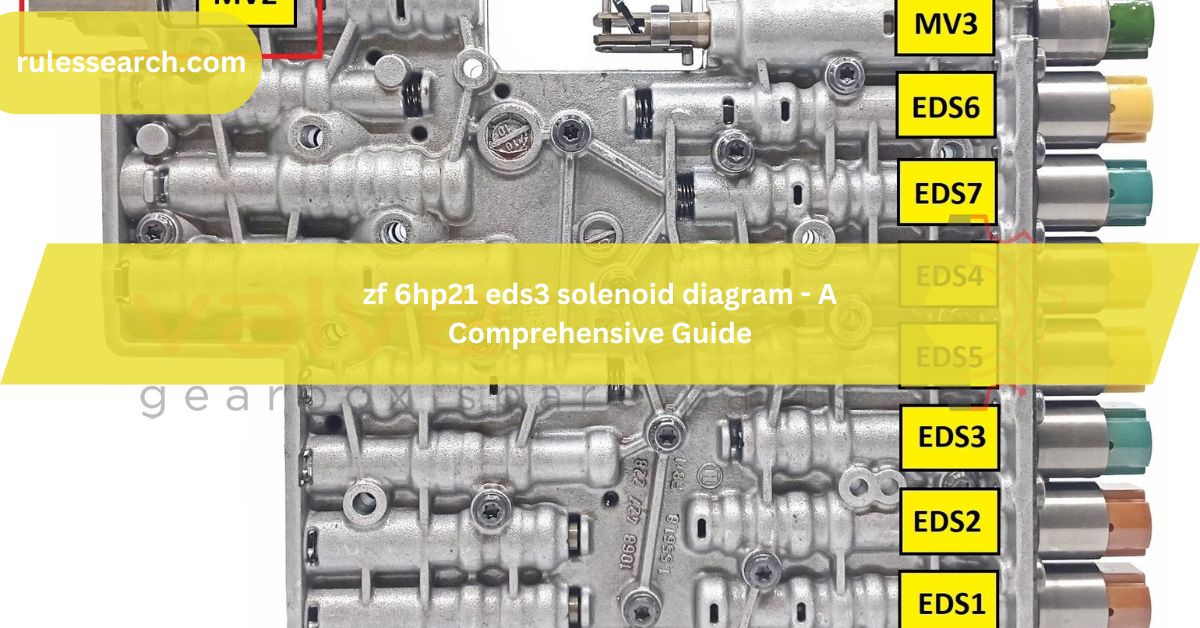The zf 6hp21 eds3 solenoid diagram transmission is known for its efficiency and smooth performance, and at its core is the EDS3 solenoid, a crucial component that helps control the transmission fluid flow.
In this guide, we will delve deeply into the ZF 6HP21 EDS3 solenoid diagram, exploring its significance, components, and how it functions within the transmission system.
What is the zf 6hp21 eds3 solenoid diagram Transmission?
The zf 6hp21 eds3 solenoid diagram1 is a 6-speed automatic transmission developed by ZF Friedrichshafen AG. It is designed to offer a balance of performance, comfort, and fuel efficiency. The transmission is utilized in various vehicles, including luxury and high-performance cars. Its key features include smooth shifting, efficient power delivery, and enhanced driving dynamics.
Key Features of the zf 6hp21 eds3 solenoid diagram
- Six-Speed Gearbox: Provides a wide range of gears for improved acceleration and fuel efficiency.
- Adaptive Transmission Control: Adjusts shifting patterns based on driving conditions and driver behavior.
- Torque Converter: Helps to smooth out power delivery and improve driving comfort.
- Hydraulic Control System: Uses hydraulic pressure to manage gear shifts and clutch engagement.
Understanding the zf 6hp21 eds3 solenoid diagram
What is the zf 6hp21 eds3 solenoid diagram?
The zf 6hp21 eds3 solenoid diagram is an integral part of the ZF 6HP21 transmission system. It is an electronically controlled valve that regulates the flow of transmission fluid. The solenoid is responsible for controlling various hydraulic functions within the transmission, ensuring that gear shifts are smooth and efficient.
Importance of the zf 6hp21 eds3 solenoid diagram
The EDS3 solenoid plays a crucial role in the operation of the ZF 6HP21 transmission. Its main functions include:
- Fluid Flow Control: Regulates the amount of transmission fluid directed to different parts of the transmission.
- Gear Shift Precision: Ensures that gear shifts occur smoothly and at the appropriate time.
- Transmission Longevity: Helps prevent excessive wear and tear by maintaining optimal fluid pressure and flow.
A malfunctioning EDS3 solenoid can lead to various transmission issues, including rough shifting, slipping gears, and decreased performance.
Components of the EDS3 Solenoid System
Solenoid Valve
The solenoid valve is the primary component of the EDS3 solenoid. It is an electrically operated valve that opens and closes to control the flow of transmission fluid. The valve’s position is adjusted based on signals from the transmission control unit (TCU), which determines the amount of fluid needed for each gear shift.
Key Functions
- Control Fluid Pressure: Adjusts the pressure of the transmission fluid to ensure proper engagement of clutches and bands.
- Manage Fluid Distribution: Directs fluid to specific parts of the transmission to achieve smooth gear changes.
Electrical Connector
The electrical connector links the EDS3 solenoid to the TCU. It transmits electrical signals that command the solenoid to adjust fluid flow. The connector must be securely attached and free from damage to ensure proper solenoid operation.
Key Functions
- Transmit Commands: Sends signals from the TCU to the solenoid to regulate fluid flow.
- Ensure Connectivity: Maintains a stable connection to prevent communication issues.
Fluid Channels
Fluid channels are pathways within the transmission that guide the transmission fluid to various components. The EDS3 solenoid regulates these channels, ensuring that fluid reaches the right areas at the right time.
Key Functions
- Direct Fluid Flow: Ensures fluid is delivered to the correct locations for optimal transmission performance.
- Prevent Blockages: Keeps channels clear to avoid disruptions in fluid flow.
How the EDS3 Solenoid Functions
Receiving Signals
The EDS3 solenoid receives electrical signals from the TCU. These signals contain information about the driving conditions and required adjustments. The solenoid interprets these signals to determine the appropriate level of fluid flow needed.
Process
- Signal Interpretation: The solenoid decodes the commands from the TCU.
- Fluid Adjustment: Based on the signals, the solenoid adjusts the valve position to regulate fluid flow.
Adjusting Fluid Flow
The solenoid valve adjusts the flow of transmission fluid through the transmission. By changing the amount of fluid allowed to pass through, the solenoid controls the pressure applied to clutches and bands, which affects gear shifting.
Process
- Regulate Pressure: Adjusts fluid pressure to match the needs of different gears.
- Control Engagement: Ensures clutches and bands engage and disengage smoothly.
Ensuring Smooth Gear Shifts
The EDS3 solenoid plays a crucial role in ensuring that gear shifts are smooth and precise. By managing the fluid flow, it helps maintain the correct pressure for each gear, leading to a seamless driving experience.
Process
- Maintain Pressure: Keeps pressure consistent for smooth gear engagement.
- Adjust Timing: Ensures that shifts occur at the optimal time for performance and comfort.
Common Issues with the EDS3 Solenoid
Symptoms of a Faulty Solenoid
- Harsh Shifting: If the transmission shifts abruptly or roughly, it may indicate a problem with the solenoid.
- Slipping Gears: Difficulty in maintaining gear engagement can be a sign of solenoid malfunction.
- Warning Lights: Many vehicles have dashboard warning lights that activate when there is a transmission issue.
Diagnosing Solenoid Problems
- Diagnostic Scanning: Use a diagnostic scanner to check for error codes related to the transmission system. This can help identify issues with the solenoid.
- Visual Inspection: Examine the solenoid for physical damage, leaks, or loose connections.
- Fluid Flow Tests: Measure the fluid flow to ensure it meets the manufacturer’s specifications.
Maintenance and Repair of the EDS3 Solenoid
Regular Maintenance Tips
- Check Transmission Fluid: Regularly inspect and replace the transmission fluid according to the manufacturer’s recommendations. Clean fluid helps ensure proper solenoid function.
- Inspect Solenoid: Periodically check the solenoid for signs of wear or damage. Early detection of problems can prevent more significant issues.
- Address Issues Promptly: If you notice symptoms of solenoid problems, address them as soon as possible to prevent further damage to the transmission.
Repair and Replacement
- Solenoid Replacement: If the solenoid is determined to be faulty, it should be replaced with a high-quality part. Ensure the replacement solenoid is compatible with the ZF 6HP21 transmission.
- Professional Service: For complex issues or if you are unsure about the repair process, it is advisable to consult a professional mechanic with experience in transmission systems.
Conclusion:
The ZF 6HP21 EDS3 solenoid is a critical component in the smooth operation of the transmission system. Understanding its function, components, and common issues can help in maintaining and troubleshooting your vehicle’s transmission.
Regular maintenance and prompt attention to any problems will ensure that your transmission remains in optimal condition.
FAQ’s:
1. What is the function of the EDS3 solenoid in the ZF 6HP21 transmission?
The EDS3 solenoid controls the flow of transmission fluid, which is essential for smooth gear shifts and overall transmission performance. It regulates fluid pressure and directs it to the necessary components within the transmission.
2. How can I tell if my EDS3 solenoid is failing?
Symptoms of a failing solenoid include harsh or rough gear shifts, slipping gears, and the illumination of a warning light on the dashboard. If you experience any of these issues, it may indicate a problem with the solenoid.
3. Can I replace the EDS3 solenoid myself?
While some individuals with mechanical experience may attempt to replace the solenoid themselves, it is generally recommended to seek the assistance of a professional mechanic. Proper installation and calibration are crucial for the solenoid’s functionality.
4. How often should I check the transmission fluid?
Transmission fluid should be checked regularly, typically every 30,000 to 60,000 miles, depending on your vehicle’s make and model. Follow the manufacturer’s recommended maintenance schedule for the best results.
5. What are the symptoms of a faulty transmission solenoid?
Common symptoms of a faulty solenoid include erratic shifting, slipping gears, rough or harsh gear changes, and transmission warning lights. Addressing these symptoms promptly can prevent further transmission issues.
6. How does the EDS3 solenoid affect gear shifts?
The EDS3 solenoid regulates the flow of transmission fluid, which affects the pressure applied to clutches and bands. This regulation ensures that gear shifts are smooth and occur at the correct time for optimal performance.
7. What should I do if I suspect a solenoid problem?
If you suspect a solenoid problem, use a diagnostic scanner to check for error codes related to the transmission. Perform a visual inspection of the solenoid and consult a mechanic if necessary to diagnose and address the issue.
8. Is it expensive to replace an EDS3 solenoid?
The cost of replacing an EDS3 solenoid can vary depending on your vehicle and repair shop. Generally, it is a moderately priced repair, but it is important to use high-quality replacement parts for best results.
9.How can I prevent solenoid problems?
Prevent solenoid problems by regularly maintaining your transmission system. This includes checking and changing the transmission fluid as recommended, inspecting the solenoid, and addressing any issues promptly.
10. What should I do if my transmission is slipping?
If your transmission is slipping, first check the fluid level and condition. Inspect the EDS3 solenoid and other transmission components. If the problem persists, consult a professional mechanic for a thorough diagnosis and repair.



